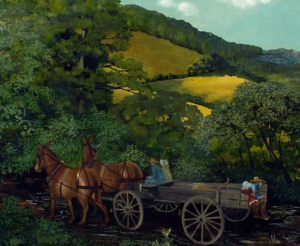
BOWLING GREEN, Ky. — The Kentucky Museum will continue to catalog and digitize their Folk Art collection with support from a $155,000 grant from the Henry Luce Foundation.
The grant will provide funding for a curator of Folk Art, a Folk Studies graduate assistantship, and consultation with quilt scholar and folklorist Laurel McKay Horton, who will collaboratively catalog and digitize the Folk Art collection into the Museum’s PastPerfect and KenCat databases.
“The Kentucky Museum is grateful for this Luce Foundation award to further assist with our Folk Art collection conservation work,” said Brent Bjorkman, director of the Kentucky Museum. “With funding for a curator for three years and support for a WKU Folk Studies graduate student to learn at the curator’s side, we are excited to provide greater access to this vibrant collection online and to allow for its expanded use as a hands-on teaching tool for all WKU students and faculty partners.”
The Kentucky Museum’s Folk Art collection includes approximately 750 works from the 1780s to the present, representing a broad range of Kentucky artistic and craft traditions. The collection includes more than 300 quilt and quilt-related textiles associated with Kentuckians, comprising one of the largest institutional quilt collections in the Commonwealth. Additionally, the Folk Art collection includes tobacco crafts, masks from the Global South and works by notable Kentucky Folk artists Helen LaFrance Orr (b. 1919), Unto Jarvi (1908-1991), Chester Cornett (1913-1981), Willie Massey (1910-1990) and Marvin Finn (1913-2007).
The collection is complemented by the work of the Museum’s partners, including the WKU Department of Art, Department of Folk Studies and Anthropology, and the Kentucky Folklife Program, as well as various Folk artists and state, regional and national Folk Art organizations. Together, these partners have helped to produce exhibits and programming, including “Standing the Test of Time: Kentucky’s White Oak Basket Traditions” (2016-17), “Backward and Forward: 20th Century Quilts” (2017) and “The Essential Tree” (2018). These efforts also include community workshops and events, such as the annual Hammer-In blacksmithing festival, that preserve, and honor south-central Kentucky’s Folk Art traditions.
Through this project, the Museum will gain knowledge critical to informing future exhibitions and programs, as well as further strategic goals related to collection development. It will also make the collection available online, 24 hours a day, seven days a week, 365 days a year, thus promoting the collection’s use in scholarship, exhibition, and educational programs.
About the Henry Luce Foundation: The Henry Luce Foundation seeks to enrich public discourse by promoting innovative scholarship, cultivating new leaders, and fostering international understanding. The Foundation advances its mission through grantmaking and leadership programs in the fields of Asia, higher education, religion and theology, art, and public policy. Established in 1936 by Henry R. Luce, the Co-Founder and Editor-in-Chief of Time, Inc., the Foundation’s earliest work honored his parents, missionary educators in China. The Foundation’s programs today reflect the value Mr. Luce placed on learning, leadership, and long-term commitment to philanthropy.
About the Kentucky Museum: Founded in 1939, the Kentucky Museum is a teaching institution with premier cultural collections that complement, support, and challenge the academic experiences of WKU students, faculty, and staff. It also provides a gathering place for our campus and community to come to know and celebrate who they are as individuals and as Kentuckians in the 21st century. The Museum serves Kentuckians and visitors from around the world through exhibitions, school and public programs, publications, and collections research. As a history and cultural museum concerned with meanings, narratives, and associations, its collections offer multiple opportunities to explore and interpret history and culture as well as discover how Kentuckians have shaped and been shaped by local, state, regional, national, and global influences over the last two-and-a-half centuries.




















Add Comment